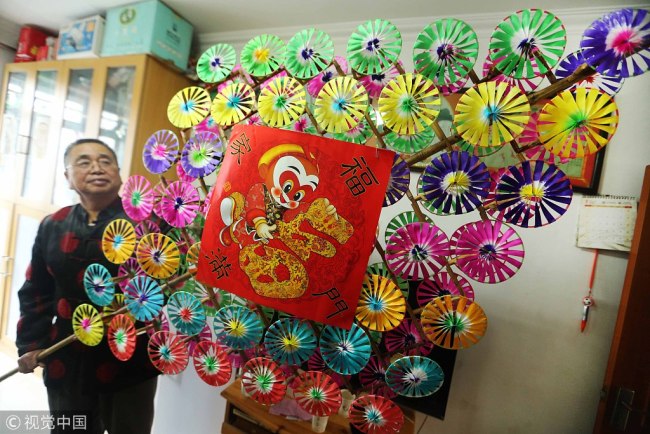Beijing paper windmill-the gift of the spring

71-year-old Wang Guohua is an inheritor of the paper windmill tradition, and the tittle 'king of windmills' has been bestowed upon him in Beijing.[Photo: VCG]
When you hear the word 'windmill', you're almost certain to picture those iconic buildings that have become a symbol of the Netherlands. Or these days the mental image might actually be a turbine, a gigantic steel structure that converts wind energy into electricity. But if you're a Beijing native, you're more likely to picture something different when you hear the word 'fengche'; you're more likely to see a simple, colorful toy that brings back memories of old times – when these 'lucky wheels' were something Chinese craftsmen made, especially around the time of Chinese New Year.
The paper windmill is one of the oldest Chinese folk handicrafts. Its history can be traced back to the Southern Song Dynasty around as early as 1,000 years ago. In an art work by the famous painter Li Song, a packman is wearing a six-blade pinwheel on his head. This is considered to be the earliest record of a windmill toy in China. After centuries of evolution, it has taken on many different styles.
Wang Guohua, a 71-year-old craftsman, is famous for his delicate paper windmills.
Wang's windmill is made from sorghum stalks, gumming dirt, paper and prods. It consists of a crisscrossing holder, wheels with colored stripes, and small paper drums.
It is believed that the turning of a windmill signifies happiness.

Wang Guohua teaches students windmill-making during a class on the traditional art form at a primary school in Beijing's Chaoyang District on Monday, March 11, 2019. [Photo: China Plus]
As the inheritor of the paper windmill, Wang Guohua is often invited by local communities and schools to give classes. Over the past few years, he has taught thousands of students in Beijing.
Please click the audio above to find out more about master craftsman Wang Guohua and the Beijing paper windmill.

